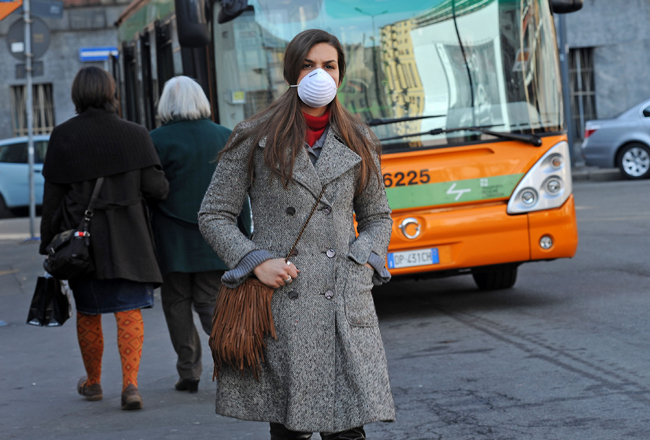Europe’s air is slowly getting cleaner, but air pollution remains the largest environmental health risk and is still responsible for about 400,000 premature deaths every year.
A new report from the European Environment Agency (EEA) presents the latest official air quality data reported by more than 4,000 monitoring stations across Europe in 2017. It shows that despite slow improvements (see Figure), high concentrations of air pollutants still have significant health impacts, with particulate matter, nitrogen dioxide (NO2) and ground-level ozone (O3) causing the greatest harm.
 Figure: Percentage of EU urban population exposed to air pollutant concentrations above WHO air quality guidelines (2000–2017).
Figure: Percentage of EU urban population exposed to air pollutant concentrations above WHO air quality guidelines (2000–2017).
Air pollution shortens people’s lives and contributes to serious illnesses such as heart disease, respiratory problems and cancer. Between 2015 and 2017, up to 81 per cent of the EU urban population was exposed to levels of fine particulate matter (PM2.5) exceeding the air quality guidelines established by the World Health Organization (WHO) to protect people’s health. And up to 98 per cent of EU urban citizens were exposed to ozone levels above the WHO’s guideline value (see Table 1).
Table 1. Percentage of EU urban population exposed to air pollutant concentrations above EU and WhO reference levels (2015–2017)

In the 41 countries considered, 412,000 premature deaths in 2016 were attributed to PM2.5 exposure, 71,000 to nitrogen dioxide exposure and 15,100 to ozone exposure. In the EU-28, the numbers of premature deaths attributed to PM2.5, NO2 and O3 exposure were 374,000, 68,000 and 14,000, respectively.
Table 2 shows the best-estimate figures for total mortality due to exposure to each of the three pollutants, for each of the European countries included in the analysis.
Table 2. Estimates of premature deaths at-tributable to exposure to PM2.5, NO2 and O3 in 41 European countries in 2016.

Country-by-country data is presented for the estimated number of years of life lost (YLL) and the YLL per 100,000 inhabitants due to exposure to the various pollutants. Regarding the latter, the largest impacts from PM2.5 are observed in the central and eastern European countries, which is also where the highest concentrations are observed, i.e. Kosovo, Serbia, Bulgaria, Albania and North Macedonia.
The largest health impacts attributable to NO2 exposure, expressed as YLL per 100,000 inhabitants, are found in Greece, Italy, Serbia, Cyprus and the United Kingdom. Regarding ozone, the countries with the highest rates of YLL per 100,000 inhabitants are Greece, Albania, Kosovo, Italy and Montenegro.
It should be noted that the impacts estimated for each pollutant may not be added to determine the total impact attributable to exposure to the three pollutants. Because concentrations – especially those of PM2.5 and NO2 – are correlated, additions may result in double counting.
In 2017, annual PM2.5 concentrations were exceeding WHO guidelines at 69 per cent of monitoring stations across Europe, including at least some monitoring stations in all reporting countries, except Estonia, Finland and Norway.
The monitoring revealed PM2.5 concentrations in excess of the binding EU limit values in seven EU member states (Bulgaria, Croatia, Czechia, Italy, Poland, Romania and Slovakia). In addition, four EU countries (Bulgaria, Hungary, Poland and Slovakia) have not yet met the EU’s 2015 target for the three-year average exposure for PM2.5.
On top of the health impacts, air pollution continues to damage vegetation and ecosystems. Elevated concentrations of ground-level ozone, for example, damage agricultural crops, forests and plants. In 2016, the EU’s long-term objective for the protection of vegetation was exceeded in 73 per cent of the total EU agricultural area, and the critical level for the protection of forests was exceeded in 62 per cent of the total EU forest area.
Excess deposition of sulphur and nitrogen compounds (from emissions of SO2, NOx, and NH3) contribute to the acidification of soil, lakes and rivers, causing the loss of biodiversity. In 2016, five per cent of the EU’s ecosystem area was exposed to acidifying depositions exceeding the limits of nature’s tolerance.
Emissions of NH3 and NOx also disrupt land and water ecosystems by introducing excessive amounts of nutrient nitrogen, causing eutrophication (the over-supply of nutrients), with resulting impacts on biodiversity. In 2016, about 73 per cent of the EU’s ecosystem area was exposed to nitrogen deposition exceeding the critical eutrophication limits.
This year’s report also includes a hypothetical assessment of the potential minimum health benefits of meeting the WHO air quality guidelines for PM2.5. The calculations were based on the assumption that all PM2.5 concentrations for 2016 over 10 μg/m3 are lowered to 10 μg/m3, while the concentrations below this level remain unchanged.
It is stressed that the estimated benefits represent a minimum, i.e. the benefits are likely underestimated. The reason being that real measures to bring down concentrations would not only lower concentrations that are currently above 10 μg/m3, but also further reduce concentrations elsewhere (that are currently below the WHO guideline).
The assessment shows that the numbers of annual premature deaths due to PM2.5 in the EU would decrease by 102,000, or 27 per cent, compared to the current figure for 2016. When all 41 of the countries considered are included, the numbers of premature deaths would fall by 122,000, or 30 per cent.
Christer Ågren
The report “Air quality in Europe – 2019 report” (EEA Report No. 10/2019) is available at: www.eea.europa.eu


































